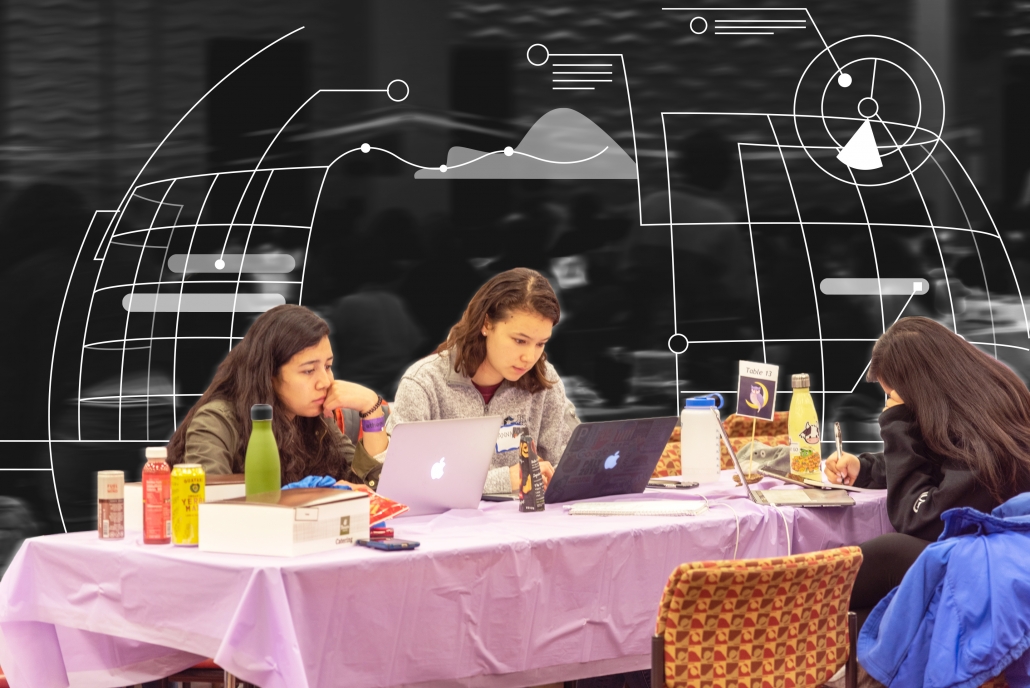Women in tech: rising above

With sleeping bags, energy drinks and laptops in tow, the attendees of AthenaHacks stream onto USC’s campus from all across the country every year to hunker down on a weekend technology project. They form small teams and attend workshops led by industry sponsors on tools to build virtual reality experiences, mobile apps and more. They listen to speakers, pitch their projects and win prizes, components of a typical hackathon. What’s not typical is that all of them — the organizers, guest speakers and participants — are women.
Women make up 26.5% of computing roles today, a step down from 36% in 1991, according to the National Center for Women and Information Technology. Across Google, Apple, Facebook, Amazon and Microsoft, known as the “Big Five” within the tech industry, the number of female employees ranges between 29.2% and 41.23% according to the company’s most recent 2020 reports. While the Viterbi School of Engineering reached gender parity for the first time with the Class of 2023, under 40% of computer science students are women and even fewer transfer students are women, according to Viterbi Dean Yannis Yortsos.
AthenaHacks is a USC hackathon launched in 2017 to address the gender gap in the tech industry. Last year, it had 450 attendees, making it the largest all-women collegiate hackathon in Southern California.
Breaking from tradition, AthenaHacks consists of women of all backgrounds who build, break and try out tech at USC. Stephanie Lampotang, an AthenaHacks organizer, experienced the gender gap firsthand during her freshman year when she attended other hackathons.
“[AthenaHacks] was my seventh hackathon of that year … but [it] was the best one,” Lampotang said. “At the other hackathons, I always felt like it was a competition, and I was a kid that was walking in the race. But … AthenaHacks felt like a group relay. Nobody was like, ‘You can’t look at what I’m doing.’”
AthenaHacks organizer Aliya Petranik, a senior majoring in computer science, said the gender ratio at a hackathon is an important factor in a hacker’s experience, especially for minorities in tech.
“The gender balance in hackathons is still quite low,” Petranik said. “Women have this idea that they can only go if they’re going to be very competitive, if they know everything already. We’re trying to change that idea and promote the idea that you can learn how to build something at a hackathon.”
In 2015, Asian women held 5% of computing positions, Black women held 3% and Latinx women held 1%, according to NCWIT. On campus, there are a host of tech clubs and initiatives highlighting women in tech, including Girls in Tech, AthenaHacks, Women in Computing and Society of Women Engineers, in addition to national organizations that support girls starting in high school such as Built By Girls and Girls Who Code.
But clubs and programs can only put a Band-Aid on problems stemming from inequity in education.
Former Built By Girls ambassador Glory Kanes, a junior majoring in computer science and business administration, emailed Yortsos in her freshman year asking the dean if they could meet to discuss diversity and inclusion in computer science at USC. This sparked a series of meetings that continues today and now includes Cheyenne Gaima, a junior majoring in computer science and business administration.
“Glory and I pretty much brought it up to our dean that while we have a pretty high number of girls entering computer science at Viterbi, we are not retaining those girls,” Gaima said.

Yortsos said he is working to make the school more inclusive for women and minorities by offering resources and training faculty to recognize and eliminate their implicit biases.
“You need to have many different views, particularly [as] technology and society are becoming intersected more and more,” said Yortsos, who described the technology industry as traditionally white- and male-dominated. “Ethics and technology ethics are very important.”
Yortsos also emphasized that Viterbi is not artificially increasing the number of women in its incoming classes but that the decreasing gender gap is the result of early structural change.
Being a minority in tech involves more than gender, as the racial gap in tech is even more prominent. Gaima said she faced related challenges in her first engineering courses.
“I was extremely excited and so ready to start … but being some of the time — or most of the time — the only Black person in a lot of my classes, I just felt so alone,” Gaima said. “When I first immediately observed it, I realized I need to find a community.”
Gaima found mentors, resources and support in the USC chapter of the National Society of Black Engineers.
Luz Camacho, vice president of the membership committee of the Society of Hispanic Professional Engineers, joined the organization because of the mentorship and friendship it offered her while navigating her freshman year.
“There’s quite a fair amount of women in computer science [at USC],” said Camacho, a junior majoring in computer engineering and computer science. “In industry, the demographics are a little different, but at least here at USC … I think I was more aware of the fact that I was the only Latina in the room than I was aware of the fact that I was one of few women.”
Kanes, Gaima and Camacho all said they had experienced imposter syndrome in certain computer science classes notorious for their difficulty, where they felt other male students already had more coding experience and could relate to the professors more easily through similar interests like video games.
“It’s this culture that’s taught toward people with … experience in this male-focused dominated industry,” Kanes said. “I passed with a 52% [in “Data Structure and Object Oriented Design”], and I got sick from that semester. It has been my goal for no woman to feel the way that I did [my freshman year].”
Until there’s a cultural change in tech, Kanes said, there will likely be no change in the future of the tech industry’s diversity.
“It’s great that we’ve reached gender parity [in Viterbi] and all,” Lampotang said. “But if you have a bunch of women in a place where 50% of the women don’t feel comfortable or things aren’t accessible or open to them, and they feel like they don’t belong, then [you] haven’t done anything.”

